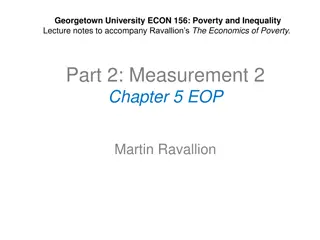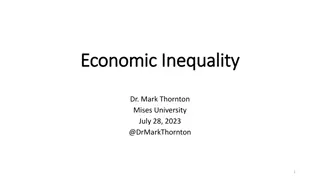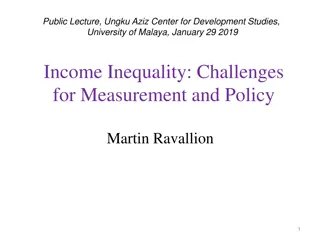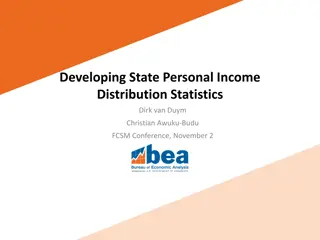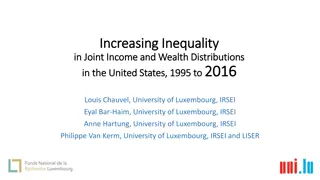Understanding Financial Instability and Economic Inequality
Explore the relationship between financial instability and economic inequality through a comprehensive analysis of factors such as housing bubbles, mortgage lending systems, unemployment cycles, GDP growth rates, bank size, and the finance sector's share of the economy. Delve into household income distribution data to gain insights into the economic landscape of the United States.
Download Presentation

Please find below an Image/Link to download the presentation.
The content on the website is provided AS IS for your information and personal use only. It may not be sold, licensed, or shared on other websites without obtaining consent from the author. Download presentation by click this link. If you encounter any issues during the download, it is possible that the publisher has removed the file from their server.
E N D
Presentation Transcript
Chapter 13 Chapter 13 Financial Instability Financial Instability and Economic and Economic Inequality Inequality
Figure 13.1 Housing Bubble and Credit Access, 1975 Figure 13.1 Housing Bubble and Credit Access, 1975 2019 2019 Sources: Federal Reserve; Shiller dataset www.econ.yale.edu/~shiller/data.htm.
Figure 13.2 (a) Traditional Mortgage Lending Structure Figure 13.2 (a) Traditional Mortgage Lending Structure
Figure 13.2 (b) Basic Structure of Securitized Mortgage Lending System Figure 13.2 (b) Basic Structure of Securitized Mortgage Lending System
Figure 13.3 Vicious Cycle of Unemployment Figure 13.3 Vicious Cycle of Unemployment
Figure 13.4 GDP per capita Growth Rates, 1999 Figure 13.4 GDP per capita Growth Rates, 1999- -2018 2018 Source: World Development Indicators, World Bank
Figure 13.5 Increasing Bank Size Figure 13.5 Increasing Bank Size Source: Federal Deposit Insurance Corporation
Figure 13.6 Finance as a Share of the Economy and Financial Profits as a Figure 13.6 Finance as a Share of the Economy and Financial Profits as a Percentage of Corporate Profits Percentage of Corporate Profits Source: U.S. Bureau of Economic Analysis, National Income and Product Accounts, Tables 6.2A-6.2D, and Thomas Piketty, Emmanuel Saez, and Gabriel Zucman. Distributional National Accounts: Methods and Estimates for the United States, Appendix tables II: Distributional series, National Bureau of Economic Research Working Paper Series, Working Paper 22945, December 2016.
Table 13.1 Household Income Distribution in the United States, 2018 Table 13.1 Household Income Distribution in the United States, 2018 Source: U.S. Census Bureau, Historical Income Tables: Households, Tables H-1 and H-2.
Figure 13.7 Gini Coefficient in the United States, 1967 Figure 13.7 Gini Coefficient in the United States, 1967- -2018 2018 Source: U.S. Census Bureau, Historical Income Tables: Households, Table H-4.
Figure 13.8 Median Household Income (2018) and Median Value of Figure 13.8 Median Household Income (2018) and Median Value of Household Assets (2016) in the United States by Race Household Assets (2016) in the United States by Race Source: Bernadette D. Proctor, Jessica L. Semega, and Melissa A. Kollar. 2016, Income and Poverty in the United States: 2015. Current Population Reports, U.S. Census Bureau, September 2016. Table 1; U.S. Census Bureau, 2019.
Figure 13.9 Annual Growth Rates of Wages and Salaries and Corporate Profit Figure 13.9 Annual Growth Rates of Wages and Salaries and Corporate Profit Source: U.S. Bureau of Economic Analysis (2017) National Income and Product Accounts, Table 1.14, 1.1.4; Bureau of Labor Statistics (2017).
Figure 13.10 Union Membership and Income Inequality, 1917 Figure 13.10 Union Membership and Income Inequality, 1917 2017 2017
Figure 13.11 Figure 13.11 Financialization Financialization and Inequality, 1929 and Inequality, 1929- -2014 2014 Source: U.S. Bureau of Economic Analysis, National Income and Product Accounts, Tables 6.2A-6.2D, BEA; Thomas Piketty, Emmanuel Saez, and Gabriel Zucman. 2016. Distributional National Accounts: Methods and Estimates for the United States. National Bureau of Economic Research Working Paper Series, Working Paper 22945, December 2016.
Figure 13.12 Change in Tax Rates by Income Group Figure 13.12 Change in Tax Rates by Income Group Source: Thomas, Piketty, Emmanuel Saez, and Gabriel Zucman. 2016. Distributional National Accounts: Methods and Estimates for the United States. National Bureau of Economic Research Working Paper Series, Working Paper 22945, December 2016.




